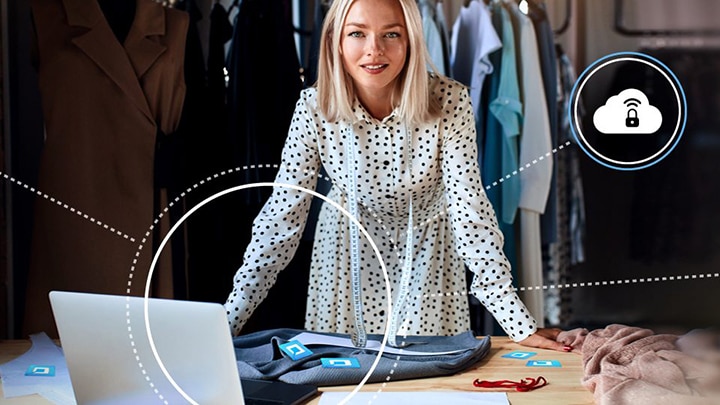Author

Kurt Bischof
Kurt Bischof is globally driving NXP RFID based marketing activities for retailers focusing on Inventory Management and Supply Chain Efficiencies.

With RAIN RFID, each pair of shoes gets its own unique identifier so it can be tracked and traced. The handheld and wall- or ceiling-mounted machines can read hundreds of items in a second, without direct line of sight, so a complete inventory can be done in just minutes, even if shoes are still in their boxes or packed in shipping cartons.
When you’re out shopping for clothes, finding the right size is important, but getting a perfect fit isn’t always a deal-breaker. If a sweater is a little snug, for example, or a t-shirt a little loose, you may still buy it.
But with shoes, it’s different. Settle for the wrong size or a poor fit and you risk more than being a little disappointed or a bit uncomfortable—you may find yourself scheduling a doctor’s visit. Overly tight dress shoes can lead to painful feet and athletic shoes that aren’t fitted properly can cause knee, hip and back pain.
To put it in stricter retail terms, our tolerance for sizing variations in clothing is relatively high but with footwear, that tolerance is close to zero. Even a small difference, from one half size to the next, can really change how a shoe performs, so if a given store doesn’t have the right size in stock we’re likely to go elsewhere.
Shoe retailers know this, of course and do their best to match on-site inventories with what’s on display. But taking inventory can be time-consuming, making it difficult to ensure the right styles and sizes are on display and in stock.
This is one of the reasons why retailers are transitioning to RAIN RFID for smart inventory control. With RAIN RFID, each pair of shoes gets its own unique identifier so it can be tracked and traced. The handheld and wall- or ceiling-mounted machines can read hundreds of items in a second, without direct line of sight, so a complete inventory can be done in just minutes, even if shoes are still in their boxes or packed in shipping cartons.
What’s more, secure memory features make it possible to store data in the RAIN RFID tag, so tags can verify authenticity at checkpoints and report their whereabouts as they make their way through the supply chain.
Saks Fifth Avenue
The luxury retailer Saks Fifth Avenue is using RAIN RFID to improve inventory
and drive sales. In their flagship store in midtown Manhattan, approximately
4000 shoes are meant to be on display at any given time. Using traditional
methods of taking inventory, a process that took up to four days to complete,
Saks found that only about 65% of styles were on display. Since shoppers
can’t buy what they don’t see, Saks was struggling to meet sales
targets.
Now, with a RAIN RFID-based inventory process in place, a full cycle count for an entire sales floor takes only 20 minutes. Saks can check inventory on a daily basis and take the appropriate replenishment actions right away. The compliance rate for displaying shoes has risen to nearly 100%, with essentially all the styles planned for a given store on view and available for sale where they need to be.
Inventory data can also be posted online as part of an omni-channel approach that lets consumers make purchases online or in-store. Every item in the store with a RAIN RFID tag can be presented online so shoppers can check availability before heading to the store to see styles in person and try them on.
Using RAIN RFID as part of an omni-channel approach has been shown to boost sales by as much as 20%, with faster sales cycles and less need for late-season markdowns to clear the way for new styles. RAIN RFID also helps to reduce buffer stocks so retailers can streamline operations without creating problems with availability.
The Ultimate in Integration
Some retailers are taking integration to the next level by making the RAIN
RFID tag a part of the shoe itself. The flexible RFID inlay is embedded in the
sole so it’s hidden from sight but still readable. Integrating tags
saves time and reduces waste since there’s no need to apply a tag
before the shoe enters the supply chain, or remove it once the shoe’s
sold.
Once the sale is made, the RAIN RFID tag can be disabled or turned off to prevent reading. That way consumers can be confident that even though there’s a chip inside their shoe, the chip will neither record nor disclose information once it’s left the store. By moving the RAIN RFID chip into privacy mode after the purchase and explaining this action to consumers, retailers can reassure customers that despite the inlay’s presence, an “unwanted guest” won’t climb into their shopping bag and start spying on their activities or steal their private information.
The Fight Against Fakes
Footwear is, unfortunately, a common target for counterfeiters, in part
because sought-after brands can retail at high prices and in part because fake
brands can be relatively easy to pass off as genuine. As just one recent
example, in September 2018, US Customs and Border Protection officers in New
York seized more than 9000 pairs of imitation athletic shoes, valued at nearly
US$1.7 million. That particular shipment of counterfeit shoes didn’t
make it to stores, but many others do.
This is changing with RAIN RFID since tagged shoes can verify their authenticity by reporting their origins and asserting their provenance. Customs officials (and anyone else in the supply chain who has the right kind of tag reader) can check and confirm authenticity in an instant, to help ensure only genuine products make their way to store shelves. Not only does that help preserve revenue for retailers, it helps boost confidence in the buying public that brands can be trusted to be real, whether they’re bought online or in the store.
NXP’s Groundbreaking UCODE 8 RAIN RFID family
NXP is a long-time leader in RAIN RFID. Our
UCODE
implementation is a top choice for retail, due to its performance, flexibility
and security. The most recent family of products,
UCODE 8, offers exceptional write sensitivity (-18 dBm), write speed (32 bits in 1.2
ms) and best in market read sensitivity of -23 dBm, for quick programming and
fast, highly accurate inventory counts.
UCODE 8 supports a 16-bit identifier and enables insertion of the Brand ID during chip production so the ID can be locked before shipment. The brand ID is located in a separate, undisclosed memory location for added protection from unauthorized access. Our Auburn-certified inlays are available in more than 20 different formats, including small-scale designs in each category, so it’s easy to find the right configuration for a given application.
NXP was also the first to issue RAIN RFID tags with GS1 G2V2 standard privacy mode, which lets the tag be disabled after sale. The NXP implementation is highly flexible, making it possible to hide all or part of the chip’s electronic product code (EPC), tag identifier (TID) and user memory. It also reduces the read range so it’s harder to access chip data. Optional password protection adds an extra layer of security and can be used to unlock privacy mode for in-store returns.
To learn more about how UCODE 8 RAIN RFID is a step forward for the footwear industry, download our new Footwear infographic.
Tags: Industrial, Retail Automation

Globally Driving RFID Based Marketing, NXP Semiconductors
Kurt Bischof is globally driving NXP RFID based marketing activities for retailers focusing on Inventory Management and Supply Chain Efficiencies.

May 7, 2020
by Mahdi Mekic

May 26, 2020

July 9, 2020
by Kurt Bischof